BMW in Formula One facts for kids
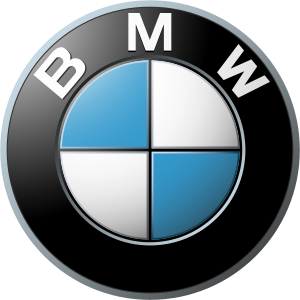 |
|
| Full name | BMW Sauber F1 Team (2006–2009) |
|---|---|
| Base | Hinwil, Switzerland Munich, Germany |
| Noted staff | Mario Theissen Peter Sauber Willy Rampf Willem Toet Andy Cowell Andreas Seidl |
| Noted drivers | |
| Formula One World Championship career | |
| First entry | 1952 German Grand Prix |
| Races entered | 72 |
| Engines | BMW |
| Constructors' Championships |
0 |
| Drivers' Championships |
0 |
| Race victories | 1 |
| Podiums | 17 |
| Points | 308 |
| Pole positions | 1 |
| Fastest laps | 2 |
| Final entry | 2009 Abu Dhabi Grand Prix |
| Formula One World Championship career | |
|---|---|
| First entry | 1952 British Grand Prix |
| Last entry | 2009 Abu Dhabi Grand Prix |
| Races entered | 273 (270 starts) |
| Chassis | Frazer Nash, AFM, Balsa, Heck, Krakau, Nacke, Reif, Greifzu, Klenk, Lola, BMW, Brabham, ATS, Arrows, Benetton, Williams, BMW Sauber |
| Constructors' Championships | 0 |
| Drivers' Championships |
1 (1983) |
| Race victories | 20 |
| Podiums | 86 |
| Points | 1,021 |
| Pole positions | 33 |
| Fastest laps | 33 |
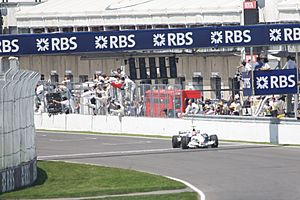
The German car company BMW has been a part of Formula One racing since it began in 1950. BMW first joined a few races in the 1950s and 1960s. Later, in the 1980s, they built a powerful turbocharged engine called the BMW M12/13.
This engine was used by the Brabham team from 1982 to 1987. During this time, Nelson Piquet won the 1983 championship with a Brabham-BMW car. BMW also supplied this engine to other teams like ATS, Arrows, Benetton, and Ligier. In 1988, BMW stopped its official support, and the engines were used by Arrows under the "Megatron" name. Turbocharged engines were banned in 1989, so the M12/13 engine could no longer be used.
BMW returned to Formula One in the late 1990s. They partnered with the Williams team, which needed a new engine supplier. BMW created a new V10 engine that first raced in 2000. The partnership started strong, with the team challenging for wins. However, they couldn't win a championship because Michael Schumacher and Ferrari were very dominant in the early 2000s.
By 2005, the relationship between BMW and Williams wasn't working well. BMW decided to leave Williams and instead bought the Sauber team. The new BMW Sauber team raced from 2006 to 2009. This move made the Sauber team much more competitive. They had two podium finishes in their first year. In 2007, they finished third in the Constructors' Championship, which became second after McLaren was disqualified.
In 2008, Robert Kubica won the team's only race, the 2008 Canadian Grand Prix. He even led the Drivers' Championship for a while. However, the team decided to focus on developing their car for 2009, and their performance dropped. The 2009 season was disappointing, as their car, the F1.09, wasn't competitive. Because of this, and the global financial crisis, BMW decided to leave Formula One. They sold the team back to its founder, Peter Sauber.
Contents
Early Races (1950s-1960s)
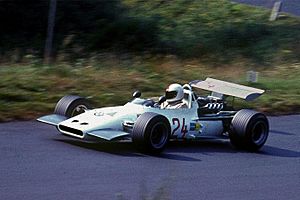
In the early years of the World Drivers' Championship after World War II, private BMW cars raced in the 1952 and 1953 German Grands Prix. These cars were based on the older BMW 328 chassis. Other companies like Alex von Falkenhausen Motorenbau (AFM) and Veritas also entered BMW-powered cars. This was possible because the championship used Formula Two rules at the time.
One interesting BMW car had its engine in the back, called the "Heck" (German for "rear"). This design became common in Formula One in the 1960s.
In the 1960s, the Formula One German Grand Prix often included Formula Two races. This allowed BMW F2 cars to compete. In 1967, BMW entered Hubert Hahne in a Lola F2 car with a larger BMW engine. This made it fit Formula One rules. In 1968, Hahne finished tenth, which was BMW's best result so far.
For the 1969 race, BMW entered three of its own 269 F2 cars. Drivers were Hahne, Gerhard Mitter, and Dieter Quester. Sadly, Mitter was fatally injured in a practice accident, and the rest of the team withdrew.
BMW as an Engine Supplier
Brabham and Other Teams (1982–1988)
After Renault found success with turbocharged engines in Formula One, BMW decided to build its own turbo engine. They announced this plan in April 1980. The engine was based on the M10 unit, a four-cylinder engine designed in the 1950s. Its racing version, the M12, had already won races in Formula Two.
BMW developed a powerful 1.4-litre turbo engine. This engine, called the M12/13, was supplied to five teams from 1982 to 1988. BMW decided to work exclusively with the Brabham team.
Testing of the M12/13 engine began in late 1980. Brabham designed a new car, the BT50, for this engine. The BT50 was longer and had a bigger fuel tank. It was also one of the first F1 cars to use telemetry to check the engine. The car was not very reliable at first, but it improved with new electronic systems.
Brabham started the 1982 season with BMW-powered cars. Nelson Piquet and Riccardo Patrese qualified well but retired early. The team faced challenges with reliability. However, at the Canadian Grand Prix, Piquet won, giving BMW its first Formula One victory.
For the rest of 1982, both drivers used the BT50. They used a new strategy of planned pit stops for refueling. This helped them run at the front of the race. Piquet also achieved BMW's first pole position at the Austrian Grand Prix.
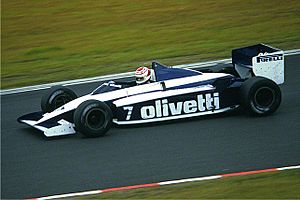
In 1983, the BMW engine became more reliable in the new BT52 car. This allowed Piquet to win the Drivers' Championship. Brabham also finished third in the Constructors' Championship. BMW also started supplying engines to the ATS team, but they didn't score points.
In 1984, BMW supplied engines to three teams, including Arrows. Piquet couldn't defend his title, as McLaren dominated. He took nine pole positions but retired from many races. He did win the Canadian and Detroit Grands Prix.
In 1985, Brabham switched to Pirelli tyres, which didn't work out well. Piquet only won one race, the French Grand Prix. Arrows, however, had a much better season, scoring 17 points.
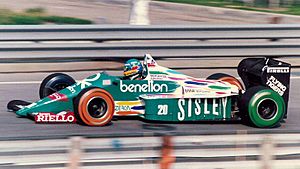
For the 1986 season, Brabham used a new car design, the BT55. BMW made a special engine for it that was tilted sideways. This car was not competitive. BMW's most successful partnership in 1986 was with the new Benetton team. They scored 19 points and won the Mexican Grand Prix.
BMW reduced its support in 1987, only supplying Brabham. At the end of the year, Brabham's owner, Bernie Ecclestone, decided not to race in 1988. The Arrows team continued to use the BMW engine, but it was renamed "Megatron." These engines powered Arrows cars in 1987 and 1988. Arrows finished fifth in the Constructors' Championship in 1988, their best result ever.
In 1989, turbocharged engines were banned. The M12/13 engine had won the 1983 Drivers' Championship and nine Grand Prix races. It also achieved 14 pole positions.
Williams Partnership (2000–2005)
After a ten-year break, BMW decided to return to Formula One in the late 1990s. In 1998, they signed a deal to supply engines to the Williams team. Williams had been very successful with Renault engines, but Renault left the sport.
BMW spent 18 months building and testing a new V10 engine called the E41. It was ready for the 2000 season. The engine was used in the FW22 car, driven by Ralf Schumacher and Jenson Button. Schumacher got a podium finish in the engine's first race. Williams finished third in the Constructors' Championship.
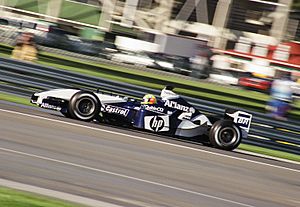
For 2001, BMW designed a more powerful engine, the P80. This engine helped Schumacher and his new teammate Juan Pablo Montoya compete for race wins. They won four races, but also lost chances due to car problems or accidents. The FW23 car was very fast on "power circuits" like Hockenheim.
In 2002, the FW24 car was more reliable. However, Ferrari's F2002 car was much faster and dominated the championships. Williams finished second in the Constructors' Championship, but only won one race. Montoya got seven pole positions but no wins.
The Williams team was more competitive in 2003. Both drivers won two races each, and Montoya was in the running for the Drivers' Championship until the second-to-last race. The FW25 car became very strong in the second half of the season.
For 2004, the team introduced the FW26 car with a unique nose design. This design didn't work well. Williams dropped to fourth in the Constructors' Championship. Montoya's victory in the Brazilian Grand Prix was their only win that year.
The final year of BMW's partnership with Williams, 2005, saw the team's performance decline further. They finished fifth in the Constructors' Championship. None of their drivers won a race. BMW felt their engines were good enough to win championships, but the Williams cars were holding them back. BMW offered to buy the team, but Frank Williams refused. So, BMW decided to buy the Sauber team instead for 2006.
BMW Sauber Team
| Full name | BMW Sauber F1 Team |
|---|---|
| Base | Hinwil, Switzerland |
| Noted staff | Mario Theissen Peter Sauber Willy Rampf Mike Krack |
| Noted drivers | |
| Formula One World Championship career | |
| First entry | 2006 Bahrain Grand Prix |
| Races entered | 70 |
| Constructors' Championships |
0 (Best finish: 2nd – 2007) |
| Drivers' Championships |
0 (Best finish: 4th – Robert Kubica, 2008) |
| Race victories | 1 |
| Podiums | 17 |
| Pole positions | 1 |
| Fastest laps | 2 |
| Final entry | 2009 Abu Dhabi Grand Prix |
BMW bought the Swiss team Sauber in June 2005. This created the BMW Sauber F1 Team. BMW kept the "Sauber" name for historical reasons. The team was based at Sauber's headquarters in Hinwil, Switzerland, and BMW's headquarters in Munich, Germany.
The team achieved two podium finishes and came fifth in 2006. In 2007, they finished second in the Constructors' Championship after McLaren was disqualified. Robert Kubica won the team's only Grand Prix victory at the 2008 Canadian Grand Prix. After a difficult 2009 season, BMW left Formula One and sold the team back to its founder, Peter Sauber.
2006 Season
For the 2006 season, BMW Sauber signed Nick Heidfeld and kept Jacques Villeneuve. Robert Kubica was the team's test driver. The team used Sauber's facilities for building the car and testing. BMW's Munich base built the new 2.4-litre V8 engine. The team's main sponsors, Petronas and Credit Suisse, stayed with them. They also partnered with Intel. The cars were blue, white, and red.
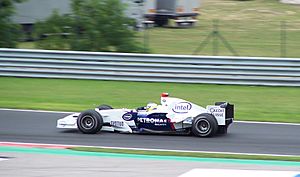
Villeneuve scored the team's first points at the Malaysian Grand Prix. Heidfeld finished fourth at the Australian Grand Prix. The team tried a new "twin towers" design on the front of the car at the French Grand Prix. However, the FIA banned these parts because they blocked the drivers' view.
Heidfeld got the team's first podium finish at the Hungarian Grand Prix. This race also marked the debut of Robert Kubica, who replaced Villeneuve. Kubica finished seventh but was later disqualified because his car was too light. Kubica then got BMW Sauber's second podium at the Italian Grand Prix. The team scored 36 points and finished fifth in the Constructors' Championship.
2007 Season
On October 19, 2006, BMW confirmed that Robert Kubica and Nick Heidfeld would be their drivers for the 2007 season. Sebastian Vettel became the test driver. The team launched their 2007 car, the F1.07, on January 16, 2007.
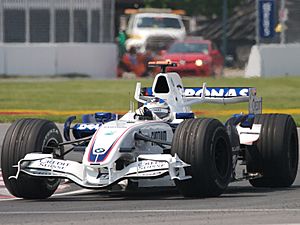
The new car looked promising in testing. In the early races, Heidfeld and Kubica consistently scored points. BMW Sauber became the third-fastest team, behind Ferrari and McLaren.
The Canadian Grand Prix was eventful. Heidfeld finished second, the team's best result so far. However, Kubica had a big crash. He was okay, only suffering a sprained ankle and concussion. Sebastian Vettel took his place for the United States Grand Prix. Vettel finished eighth, becoming the youngest driver to score a Formula One point at that time. Later in the season, Vettel moved to the Toro Rosso team.
Kubica returned at the French Grand Prix and finished fourth. He and Heidfeld continued to perform well, scoring 101 points in total. This secured the team second place in the Constructors' Championship after McLaren's disqualification.
2008 Season
On August 21, 2007, BMW confirmed that Nick Heidfeld and Robert Kubica would continue as their drivers for the 2008 season. Their 2008 car, the F1.08, was launched on January 14, 2008. Team boss Mario Theissen aimed for the team's first win.
BMW Sauber started the season well. Kubica almost got pole position in Melbourne. Heidfeld finished second. In Malaysia, Kubica took second place, and Heidfeld set the fastest lap. In Bahrain, Kubica achieved his and the team's first ever pole position. The team finished third and fourth in the race, putting them in first place in the constructors' championship for the first time.

The team also finished second at the Monaco Grand Prix with Robert Kubica. BMW Sauber's first race victory came at the 2008 Canadian Grand Prix. The team achieved a one-two finish, with Robert Kubica winning and Nick Heidfeld taking second place. This happened after Lewis Hamilton crashed with Kimi Räikkönen in the pitlane.
After this win, the team decided to focus on developing their car for the 2009 season. This decision disappointed Kubica, who was leading the championship at the time. The lack of development caused their performance to drop in the second half of the season. Despite this, Kubica still had a chance to win the drivers' championship until the Chinese Grand Prix. In October, the team confirmed that Kubica and Heidfeld would remain their drivers for 2009.
2009 Season
BMW Sauber hoped to challenge for the title in 2009, but the season started poorly. Kubica crashed out of the opening race. Heidfeld got the team's first podium in Malaysia. However, after six races, BMW Sauber had only 6 points and was in eighth place.
The team planned upgrades, including an improved KERS system and a double diffuser. While the new diffuser was used, the KERS system didn't fit the new car. The team later decided to stop developing KERS and focus on improving the car's aerodynamics. In the European Grand Prix, Robert Kubica scored the team's first points since the Turkish race.
After a meeting on July 28, BMW announced they would leave Formula One at the end of 2009. They said it was a strategic decision. On September 15, 2009, it was announced that Qadbak Investments Limited would buy BMW Sauber. However, this deal failed because Qadbak did not have the money.
On November 27, 2009, it was announced that Peter Sauber would buy the team back. This depended on the team getting an entry for the 2010 season. The FIA then granted Sauber an entry on December 3, after Toyota left the sport. The team used Ferrari engines in 2010.
BMW Engine Results (1952–2005)
| Entrant | Season(s) | Total wins | First win | Last win | Pole Positions | First Pole | Last Pole |
|---|---|---|---|---|---|---|---|
| 1952 | 0 | - | - | 0 | - | - | |
| 1952–1953 | 0 | - | - | 0 | - | - | |
| 1952 | 0 | - | - | 0 | - | - | |
| 1952 | 0 | - | - | 0 | - | - | |
| 1952 | 0 | - | - | 0 | - | - | |
| 1952 | 0 | - | - | 0 | - | - | |
| 1953 | 0 | - | - | 0 | - | - | |
| 1954 | 0 | - | - | 0 | - | - | |
| 1967–1968 | 0 | - | - | 0 | - | - | |
| 1967 | 0 | - | - | 0 | - | - | |
| 1981–1987 | 8 | 1982 Canadian Grand Prix | 1985 French Grand Prix | 13 | 1982 Austrian Grand Prix | 1985 Dutch Grand Prix | |
| 1983–1984 | 0 | - | - | 0 | - | - | |
| 1984–1988† | 0 | - | - | 0 | - | - | |
| 1986 | 1 | 1986 Mexican Grand Prix | 1986 Mexican Grand Prix | 2 | 1986 Austrian Grand Prix | 1986 Italian Grand Prix | |
| 1987† | 0 | - | - | 0 | - | - | |
| 2000–2005 | 10 | 2001 San Marino Grand Prix | 2004 Brazilian Grand Prix | 17 | 2001 French Grand Prix | 2005 European Grand Prix | |
| Total | 1952–2005 | 19 | 1982 Canadian Grand Prix | 2004 Brazilian Grand Prix | 32 | 1982 Austrian Grand Prix | 2005 European Grand Prix |
* Excludes factory team.
† BMW engine re-badged as Megatron in 1987 and 1988.
See also
 In Spanish: BMW en Fórmula 1 para niños
In Spanish: BMW en Fórmula 1 para niños
- BMW in motorsport



